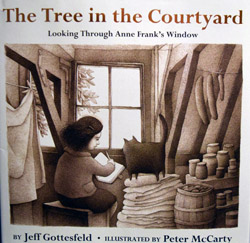The Tree in the Courtyard: Looking Through Anne Frank’s Window by Jeff Gottesfeld; illustrated by Peter McCarty; ©2016 Alfred A. Knopf, Junior Library Guild Selection; 34 pages; $17.99
By Donald H. Harrison

 SAN DIEGO – This beautifully written, magnificently illustrated, sentimental remembrance of Anne Frank is being marketed as a children’s book, but I’m not at all certain it has been targeted correctly.
SAN DIEGO – This beautifully written, magnificently illustrated, sentimental remembrance of Anne Frank is being marketed as a children’s book, but I’m not at all certain it has been targeted correctly.
The novelty of the book is its point of view; which is that of the chestnut tree that Anne could look upon from the window of the annex in which she and seven other Jews hid from the Nazis. In this imaginative treatment, the chestnut tree looks back and sees scenes that humans on the street well below its branches could not.
For example the tree could see Anne writing day after day in her red and white diary. It could see Anne’s father, Otto, comforting her, when bombers flew overhead. It could see the family surreptitiously lighting Chanukah candles. And it could see Anne and the boy who lived in the annex, Peter, share a first kiss. It also saw men in uniforms pull Anne and the others out of the annex and drive them away.
Seasons and years went by and the tree saw Otto return alone, without the girl or the rest of his family. It saw Otto look through the diary that had been saved by the woman who came to the annex to bring food and help them, Miep Gies. And after time passed, it could see other children from all over the world coming to the annex to see where Anne had lived.
As humans die, so too do trees. Medicine could not cure the tree’s ailment, and when the tree was struck by lightning it died. But before that happened, the tree’s seeds and saplings were saved for planting in various places around the world, including: New York City, at the National September 11 Memorial & Museum; at Central High School in Little Rock, once the focus of the integration battle; at the Anne Frank Peace Park in Indianapolis; at Harriet Tubman’s home in Aurora, New York, at the Idaho Anne Frank Human Rights Memorial in Boise; and at the Clinton Presidential Center in Little Rock, Arkansas.
Yes, it is a beautiful story, so what is my reservation? The problem is that the story is derivative. We who appreciate it know the story of Anne Frank. We have read the diary, seen the play, or watched the film. But what about the child to whom it will be read or who reads it himself or herself?
You can imagine a child asking: Who was this girl Anne Frank? Who were the people in grey coats? Why were they bombing Anne’s home? Why did Anne have to hide? Where did they take Anne?
In other words, the book opens up all the questions about the Holocaust but it doesn’t provide real answers. So where will the answers come from? Perhaps the parents who read the book, perhaps from school, or perhaps from nowhere. That is what concerns me.
*
Harrison is editor of San Diego Jewish World. He may be contacted via donald.harrison@sdjewishworld.com . Comments intended for publication in the space below must be accompanied by the letter writer’s first and last name and by his/ her city and state of residence (city and country for those outside the U.S.)